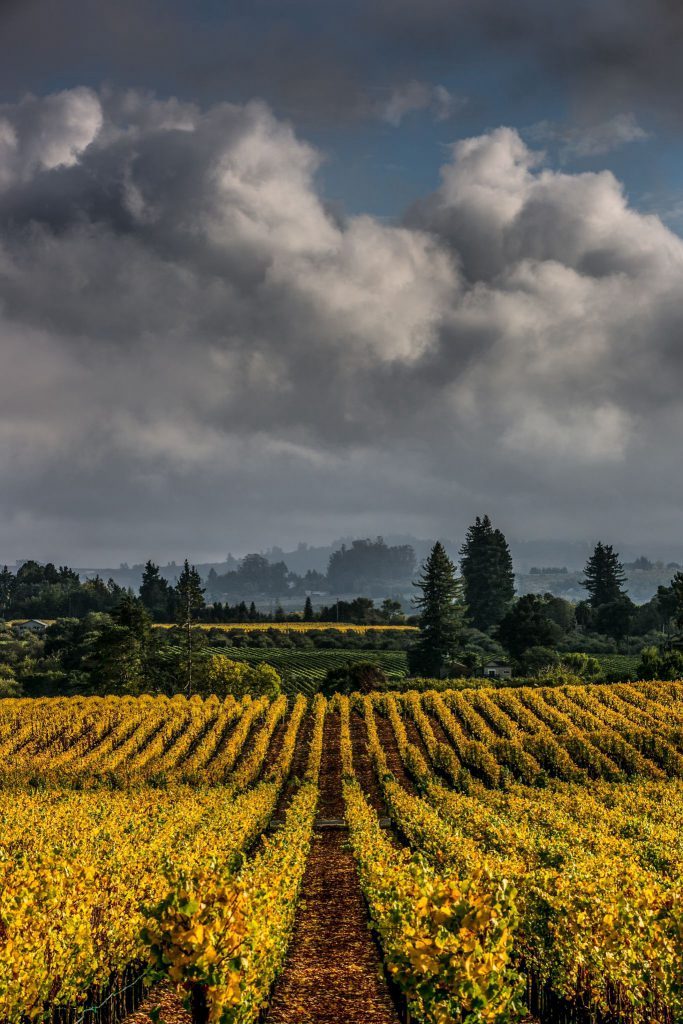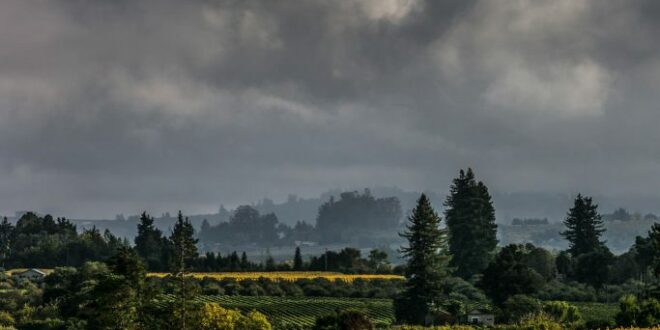
Hallberg Vineyard
Gary Farrell started his eponymous label in 1982 with Pinot Noir grapes from the Rochioli vineyard and became one of the winemaking pioneers of the Russian River Valley. He and his winery played an important role in establishing this as California’s premier region for growing and making Pinot Noir. Today, the winery that carries his name continues to source fruit from Rochioli and other iconic Russian River Valley vineyards [Hallberg Vineyard is shown here.] Indeed, it is the 40+ year continuity of this winemaker-grower relationship that is one of the strengths of the winery. That and the winemaking, which continues the fresh style initiated by Gary Farrell. Bill Price of Kistler Vineyards and Three Sticks leads the investor group that owns the winery.

Brent McKoy
Theresa Heredia has been the winemaker at Gary Farrell for the past decade and made the wines reviewed in this article. In 2023, Brent McKoy, who began working at Gary Farrell in 2005, was named winemaker with Theresa continuing as consulting enologist. We first met Theresa at Joseph Phelps’ Freestone Vineyards on the Sonoma Coast where we had earlier tasted with Joseph Phelps winemaker Craig Williams. Theresa was named winemaker at Gary Farrell in 2012 and introduced changes in winemaking that contributed to complexity and a deeper sense of place in addition to the brand’s traditional freshness and purity. We’ve reviewed her consistently excellent wines over the past decade, and we look forward to continue tasting the Gary Farrell wines with Brent.

Rochioli Vineyard
Chardonnay
Gary Farrell 2022 Chardonnay Russian River Selection Russian River Valley ($40) 92 Light yellow. This blend of some of the most noted vineyards of the Russian River Valley offers an excellent Chardonnay at a reasonable price. It’s a good example of the Gary Farrell style that puts the focus on freshness and vibrancy. There’s an overall richness of flavor with lemony acidity, orchard and citrus fruit and good extract on the finish. Sourced from several vineyards including Rochioli, Allen and Olivet Lane and fermented and aged 10 months in 30% new French oak.
Gary Farrell 2021 Chardonnay Olivet Lane Russian River Valley ($50) 93 Lively bouquet of orchard fruit with a toasty oak accent. Bright on the attack with tangy acidity and density of citrus and tart apple flavors. Chablis like in its minerality and purity. Sourced from Pellegrini’s Olivet Lane Vineyard on the Santa Rosa Plain planted in 1975 to Wente selection. Fermented with Montrachet yeast and aged 10 months in 35% new French oak. pH 3.23, 13.2% alc.
Gary Farrell 2021 Chardonnay Ritchie Vineyard Russian River Valley ($75) 94 Pale yellow straw. Nuanced aromas of Bosc pear, lemon oil, and a hint of ginger. Excellent volume on a well-structured palate with firm edged flavors. Beautiful purity, juicy acidity and excellent delineation; quite firm and refined with a fresh minerality. Lovely rich, dry finish. Sourced from Ritchie vineyard and fermented and aged 10 months in 35% new, 65% neutral French oak barrels. pH 3.20, 14% alc.
Gary Farrell 2021 Chardonnay Rochioli Vineyard Russian River Valley ($75) 95 A stunning wine! Sumptuous nose of waxy Meyer lemon and cling peach with floral notes. Elegant mouth feel with excellent depth and volume, exhilarating acidity and an energetic, rich finish. Sourced mostly from the historic Rochioli Vineyard’s River Block planted in 1989, whole cluster pressed, fermented with Montrachet yeast, and aged 10 months in 35% new French oak barrels and puncheons. pH 3.21, 13.7% alc.
Rosé
Gary Farrell 2023 Rosé of Pinot Noir Russian River Valley ($45) 93 This is one of the most delightful rosés we’ve had in a long time. It opens with a nuanced floral perfume of rose petals and subtle red cherry. Very fresh on the palate with bright, penetrating cherry/berry fruit that persists on a very long finish. Beautifully balanced and very dry (but with sweet fruit). All UCD Clone 37 sourced from the Wat Vineyard near Sebastopol in the very cool Green Valley of the Russian River Valley. 13.8% alc. Only available to club members, so it’s a good reason to join.
Pinot Noir
Gary Farrell 2021 Pinot Noir Russian River Selection Russian River Valley ($50) 93 Medium ruby red. Sourced from iconic vineyards located in the diverse neighborhoods of the AVA, this wine is a beautiful representation of Russian River Valley Pinot Noir. Riper red berries and dark cherry show on the bouquet along with light earthy note. The medium weight palate is well-balanced with good acidity, an overall sense of juicy, fresh fruit, and a clean, dry finish. Sourced from vineyards located in diverse parts of the Russian River. Matured 13 months in 40% new French oak. pH 3.37, 13.9% alc.
Gary Farrell 2021 Pinot Noir Hallberg Vineyard Russian River Valley ($60) 94 Sourced from the diverse clones of the 100-acre Hallberg Vineyard in the cool, foggy Green Valley, the part of the Russian River Valley closest to the Pacific with a strong marine influence, this Pinot Noir has striking purity of flavor. The bouquet reveals dark cherry with floral and earth notes, and the palate adds rich red and black berries to the mix. It’s an elegant wine, medium weight with excellent balance and a silky mouth feel. Partially destemmed and fermented in small open top tanks followed by 15 months in 40% new French oak. pH 3.35, 13.8% alc.
Gary Farrell 2020 Pinot Noir Rochioli Vineyard Russian River Valley ($90) 95 Sourced from the historic Rochioli Vineyard’s Rochioli River Block, this is an exceptional wine made even more special by the challenges of the vintage. Intensely perfumed, it shows deep fruit aromas with savory notes. Lovely, refined and silky mouth feel and overall weight with complex, layered flavors of fruit, cassis and bergamot and a superb rich finish with excellent persistence. Fermented 15% whole cluster, in open top stainless steel and aged 15 months in 45% new French oak. pH 3.30, 13.8% alc.
Gary Farrell 2020 Pinot Noir Sanford & Benedict Vineyard Sta Rita Hills ($75) 93 This is a lovely, floral-accented, red fruited wine from Santa Barbara’s most historic Pinot Noir vineyard. It reveals excellent purity of flavor and invigorating acidity with an appealing silkiness in the mouth. Hand sorted, fermented in small open top tanks with 20% whole cluster, and aged 15 months on the lees in 40% new French oak. pH 3.32, 14.3% alc.
